Groupthink Essay: Negative Effects and Effective Mitigation Strategies
VerifiedAdded on 2023/01/19
|8
|2301
|97
Essay
AI Summary
This essay delves into the phenomenon of groupthink, a form of conformity within groups that can lead to poor decision-making. It explores the nature of groupthink, characterized by symptoms like invulnerability, self-censorship, and the illusion of unanimity. The essay examines the negative effects of groupthink, including reduced self-esteem and the limitation of alternative ideas, which can result in flawed decisions. To combat groupthink, the essay proposes strategies such as assembling diverse teams, encouraging open debate, and applying normative decision theory. The essay also highlights the ethical concerns related to groupthink, particularly regarding unanimity and the role of mind guards. In conclusion, the essay emphasizes the importance of ethical considerations in decision-making processes to avoid the negative impacts of groupthink and promote effective outcomes.
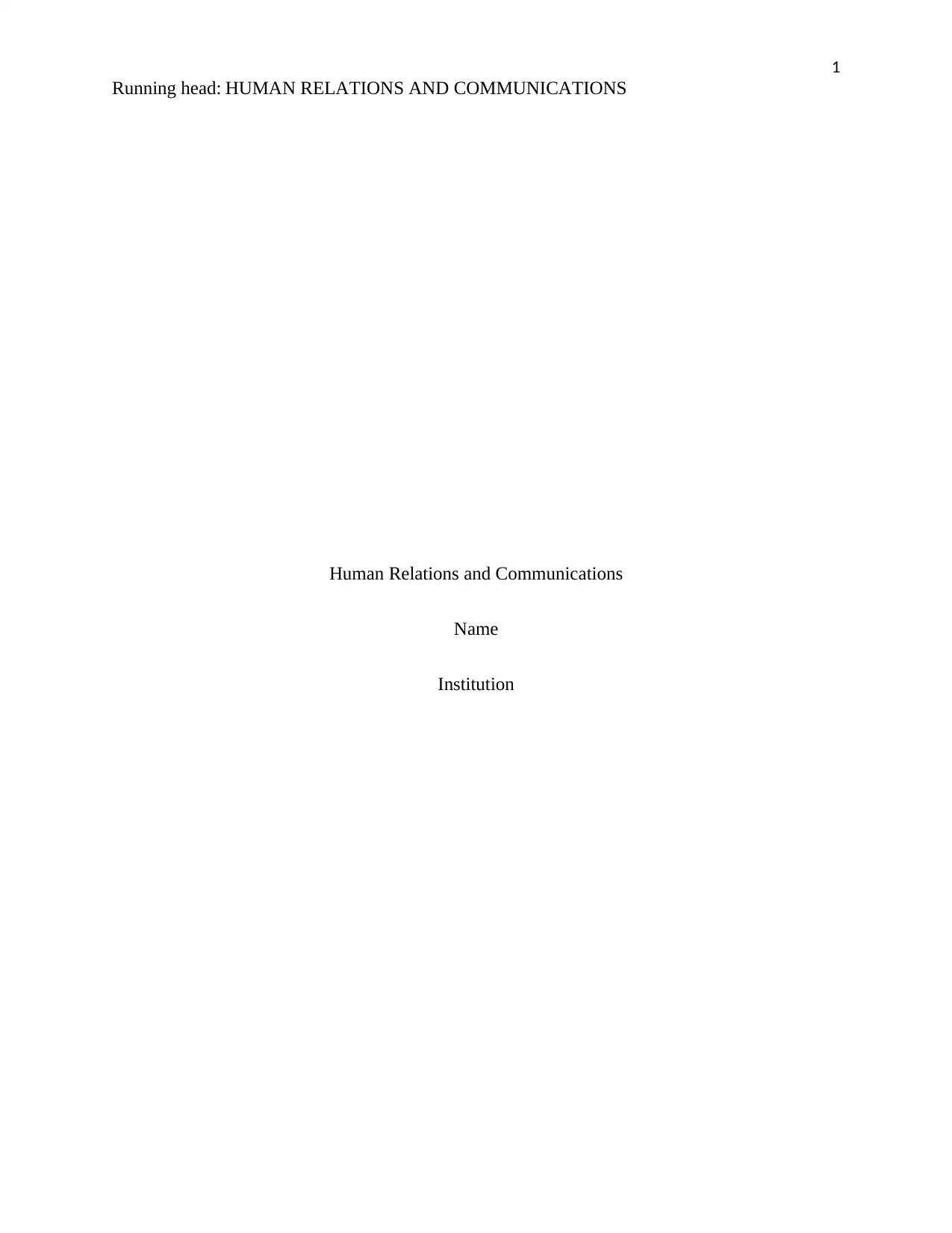
1
Running head: HUMAN RELATIONS AND COMMUNICATIONS
Human Relations and Communications
Name
Institution
Running head: HUMAN RELATIONS AND COMMUNICATIONS
Human Relations and Communications
Name
Institution
Paraphrase This Document
Need a fresh take? Get an instant paraphrase of this document with our AI Paraphraser
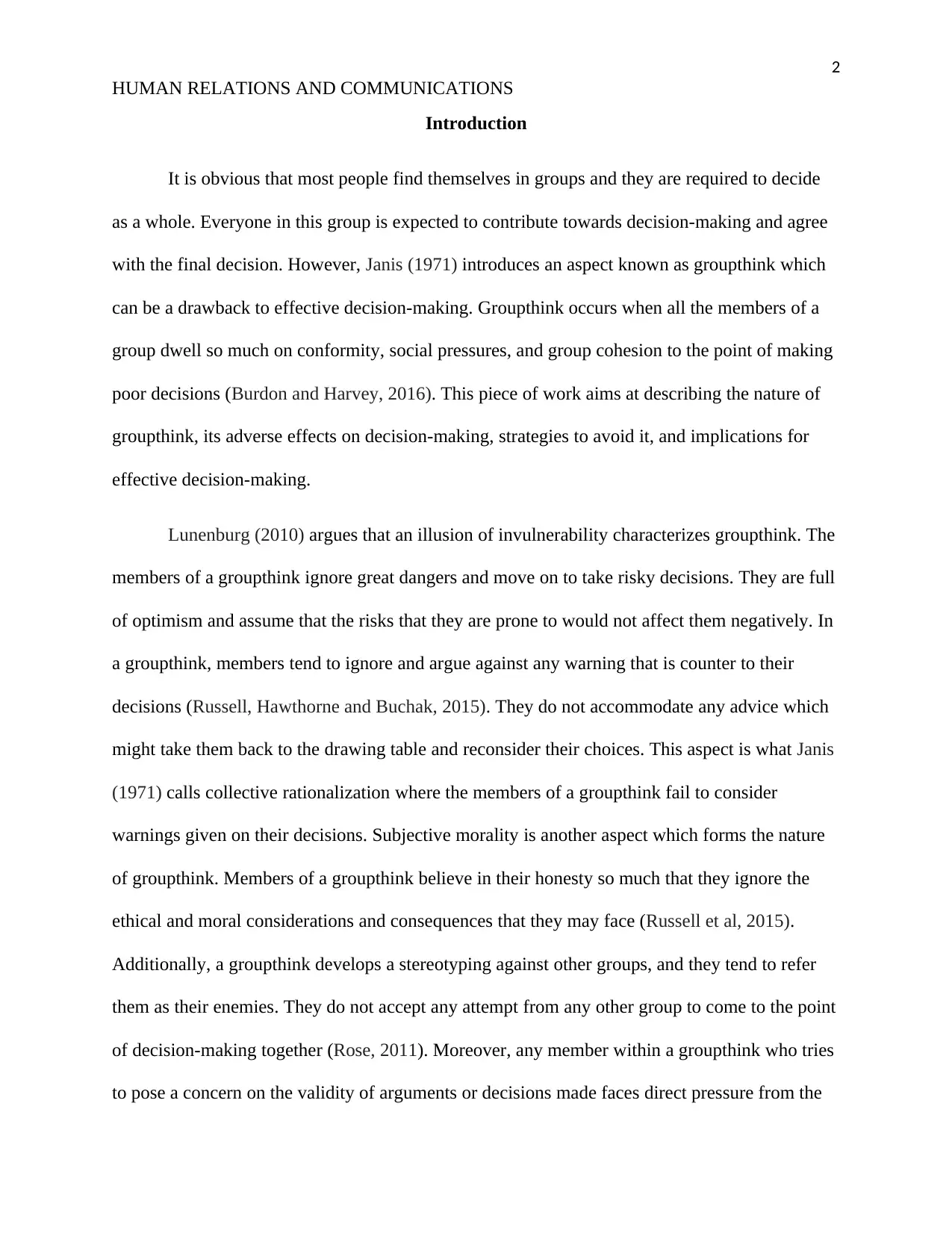
2
HUMAN RELATIONS AND COMMUNICATIONS
Introduction
It is obvious that most people find themselves in groups and they are required to decide
as a whole. Everyone in this group is expected to contribute towards decision-making and agree
with the final decision. However, Janis (1971) introduces an aspect known as groupthink which
can be a drawback to effective decision-making. Groupthink occurs when all the members of a
group dwell so much on conformity, social pressures, and group cohesion to the point of making
poor decisions (Burdon and Harvey, 2016). This piece of work aims at describing the nature of
groupthink, its adverse effects on decision-making, strategies to avoid it, and implications for
effective decision-making.
Lunenburg (2010) argues that an illusion of invulnerability characterizes groupthink. The
members of a groupthink ignore great dangers and move on to take risky decisions. They are full
of optimism and assume that the risks that they are prone to would not affect them negatively. In
a groupthink, members tend to ignore and argue against any warning that is counter to their
decisions (Russell, Hawthorne and Buchak, 2015). They do not accommodate any advice which
might take them back to the drawing table and reconsider their choices. This aspect is what Janis
(1971) calls collective rationalization where the members of a groupthink fail to consider
warnings given on their decisions. Subjective morality is another aspect which forms the nature
of groupthink. Members of a groupthink believe in their honesty so much that they ignore the
ethical and moral considerations and consequences that they may face (Russell et al, 2015).
Additionally, a groupthink develops a stereotyping against other groups, and they tend to refer
them as their enemies. They do not accept any attempt from any other group to come to the point
of decision-making together (Rose, 2011). Moreover, any member within a groupthink who tries
to pose a concern on the validity of arguments or decisions made faces direct pressure from the
HUMAN RELATIONS AND COMMUNICATIONS
Introduction
It is obvious that most people find themselves in groups and they are required to decide
as a whole. Everyone in this group is expected to contribute towards decision-making and agree
with the final decision. However, Janis (1971) introduces an aspect known as groupthink which
can be a drawback to effective decision-making. Groupthink occurs when all the members of a
group dwell so much on conformity, social pressures, and group cohesion to the point of making
poor decisions (Burdon and Harvey, 2016). This piece of work aims at describing the nature of
groupthink, its adverse effects on decision-making, strategies to avoid it, and implications for
effective decision-making.
Lunenburg (2010) argues that an illusion of invulnerability characterizes groupthink. The
members of a groupthink ignore great dangers and move on to take risky decisions. They are full
of optimism and assume that the risks that they are prone to would not affect them negatively. In
a groupthink, members tend to ignore and argue against any warning that is counter to their
decisions (Russell, Hawthorne and Buchak, 2015). They do not accommodate any advice which
might take them back to the drawing table and reconsider their choices. This aspect is what Janis
(1971) calls collective rationalization where the members of a groupthink fail to consider
warnings given on their decisions. Subjective morality is another aspect which forms the nature
of groupthink. Members of a groupthink believe in their honesty so much that they ignore the
ethical and moral considerations and consequences that they may face (Russell et al, 2015).
Additionally, a groupthink develops a stereotyping against other groups, and they tend to refer
them as their enemies. They do not accept any attempt from any other group to come to the point
of decision-making together (Rose, 2011). Moreover, any member within a groupthink who tries
to pose a concern on the validity of arguments or decisions made faces direct pressure from the
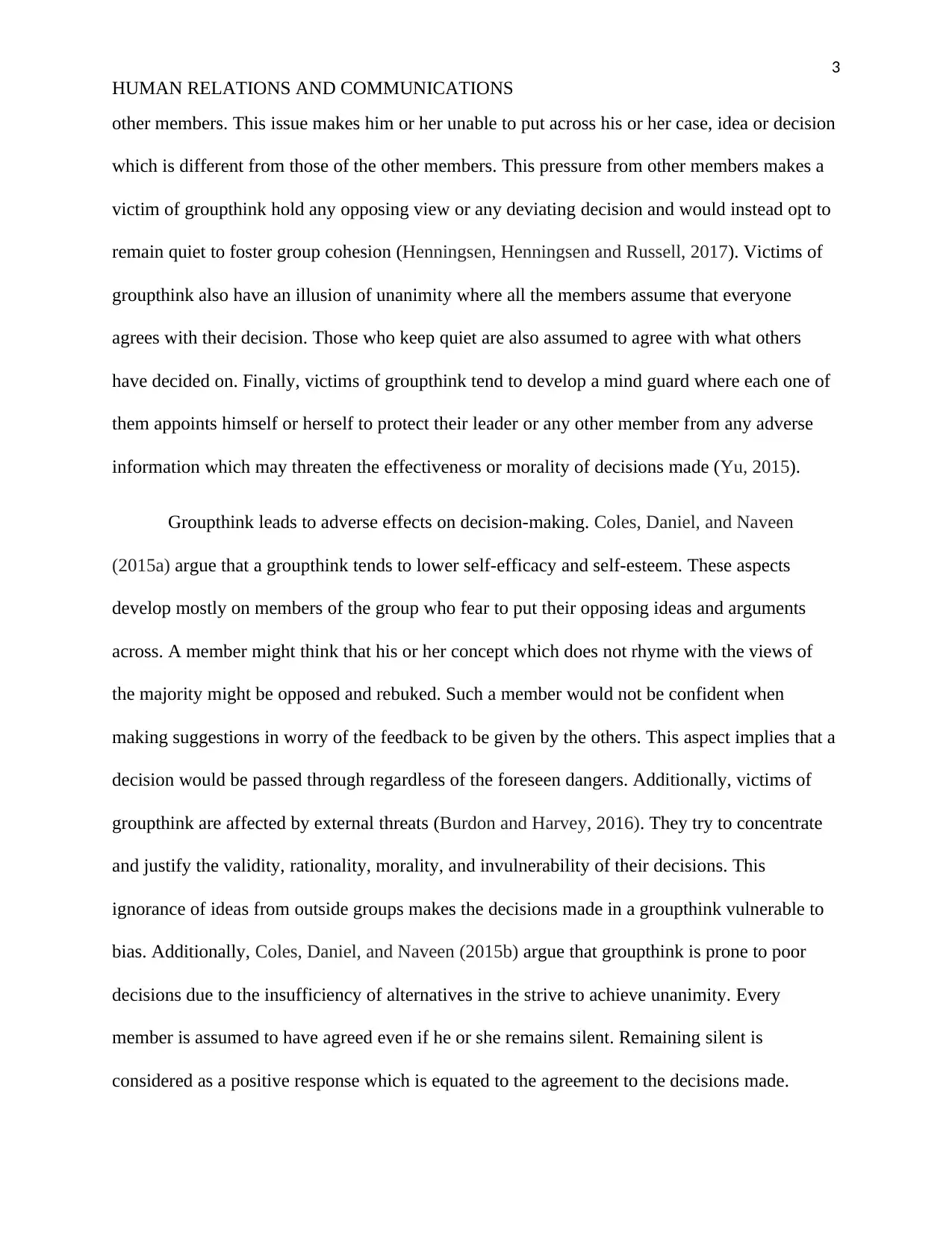
3
HUMAN RELATIONS AND COMMUNICATIONS
other members. This issue makes him or her unable to put across his or her case, idea or decision
which is different from those of the other members. This pressure from other members makes a
victim of groupthink hold any opposing view or any deviating decision and would instead opt to
remain quiet to foster group cohesion (Henningsen, Henningsen and Russell, 2017). Victims of
groupthink also have an illusion of unanimity where all the members assume that everyone
agrees with their decision. Those who keep quiet are also assumed to agree with what others
have decided on. Finally, victims of groupthink tend to develop a mind guard where each one of
them appoints himself or herself to protect their leader or any other member from any adverse
information which may threaten the effectiveness or morality of decisions made (Yu, 2015).
Groupthink leads to adverse effects on decision-making. Coles, Daniel, and Naveen
(2015a) argue that a groupthink tends to lower self-efficacy and self-esteem. These aspects
develop mostly on members of the group who fear to put their opposing ideas and arguments
across. A member might think that his or her concept which does not rhyme with the views of
the majority might be opposed and rebuked. Such a member would not be confident when
making suggestions in worry of the feedback to be given by the others. This aspect implies that a
decision would be passed through regardless of the foreseen dangers. Additionally, victims of
groupthink are affected by external threats (Burdon and Harvey, 2016). They try to concentrate
and justify the validity, rationality, morality, and invulnerability of their decisions. This
ignorance of ideas from outside groups makes the decisions made in a groupthink vulnerable to
bias. Additionally, Coles, Daniel, and Naveen (2015b) argue that groupthink is prone to poor
decisions due to the insufficiency of alternatives in the strive to achieve unanimity. Every
member is assumed to have agreed even if he or she remains silent. Remaining silent is
considered as a positive response which is equated to the agreement to the decisions made.
HUMAN RELATIONS AND COMMUNICATIONS
other members. This issue makes him or her unable to put across his or her case, idea or decision
which is different from those of the other members. This pressure from other members makes a
victim of groupthink hold any opposing view or any deviating decision and would instead opt to
remain quiet to foster group cohesion (Henningsen, Henningsen and Russell, 2017). Victims of
groupthink also have an illusion of unanimity where all the members assume that everyone
agrees with their decision. Those who keep quiet are also assumed to agree with what others
have decided on. Finally, victims of groupthink tend to develop a mind guard where each one of
them appoints himself or herself to protect their leader or any other member from any adverse
information which may threaten the effectiveness or morality of decisions made (Yu, 2015).
Groupthink leads to adverse effects on decision-making. Coles, Daniel, and Naveen
(2015a) argue that a groupthink tends to lower self-efficacy and self-esteem. These aspects
develop mostly on members of the group who fear to put their opposing ideas and arguments
across. A member might think that his or her concept which does not rhyme with the views of
the majority might be opposed and rebuked. Such a member would not be confident when
making suggestions in worry of the feedback to be given by the others. This aspect implies that a
decision would be passed through regardless of the foreseen dangers. Additionally, victims of
groupthink are affected by external threats (Burdon and Harvey, 2016). They try to concentrate
and justify the validity, rationality, morality, and invulnerability of their decisions. This
ignorance of ideas from outside groups makes the decisions made in a groupthink vulnerable to
bias. Additionally, Coles, Daniel, and Naveen (2015b) argue that groupthink is prone to poor
decisions due to the insufficiency of alternatives in the strive to achieve unanimity. Every
member is assumed to have agreed even if he or she remains silent. Remaining silent is
considered as a positive response which is equated to the agreement to the decisions made.
⊘ This is a preview!⊘
Do you want full access?
Subscribe today to unlock all pages.

Trusted by 1+ million students worldwide
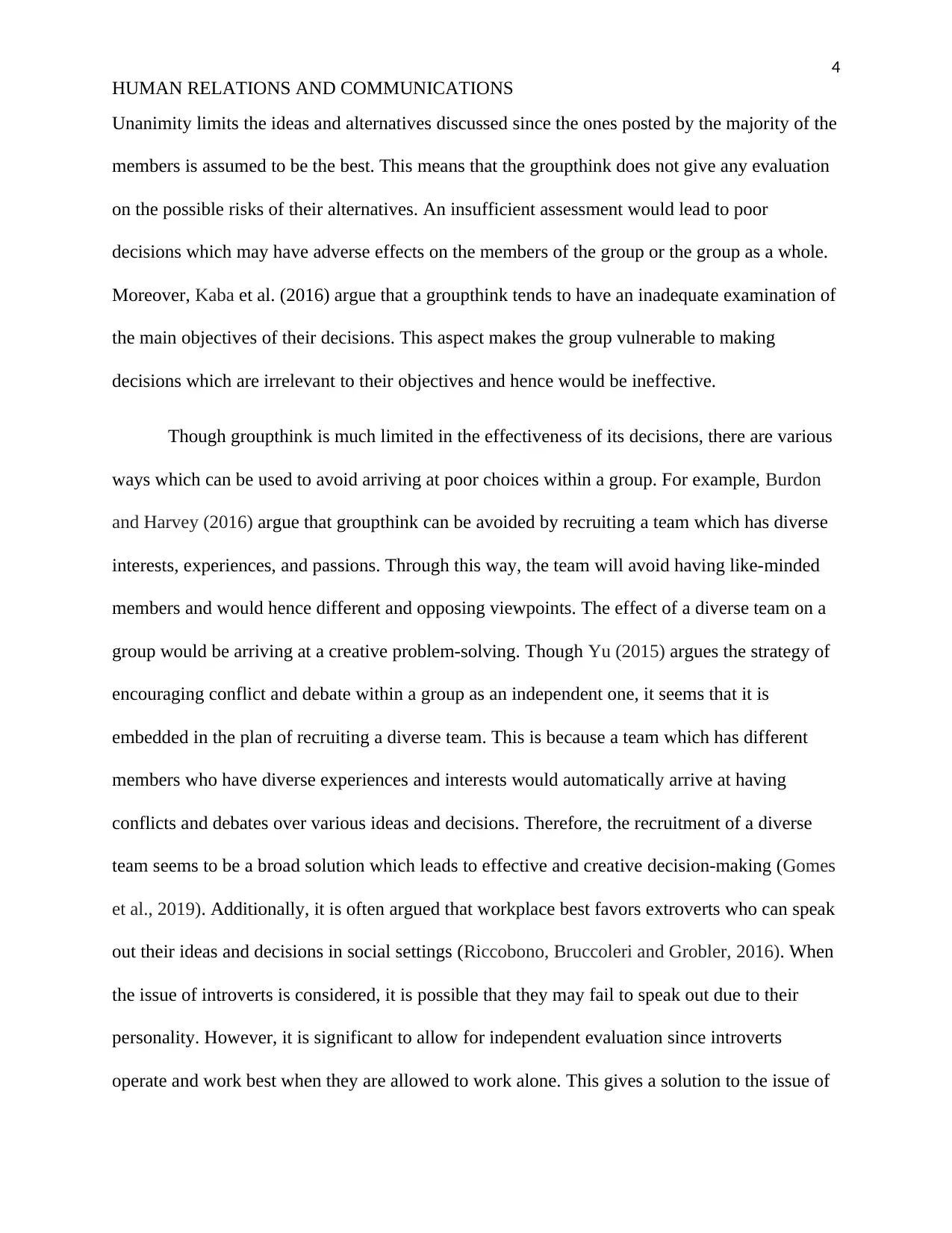
4
HUMAN RELATIONS AND COMMUNICATIONS
Unanimity limits the ideas and alternatives discussed since the ones posted by the majority of the
members is assumed to be the best. This means that the groupthink does not give any evaluation
on the possible risks of their alternatives. An insufficient assessment would lead to poor
decisions which may have adverse effects on the members of the group or the group as a whole.
Moreover, Kaba et al. (2016) argue that a groupthink tends to have an inadequate examination of
the main objectives of their decisions. This aspect makes the group vulnerable to making
decisions which are irrelevant to their objectives and hence would be ineffective.
Though groupthink is much limited in the effectiveness of its decisions, there are various
ways which can be used to avoid arriving at poor choices within a group. For example, Burdon
and Harvey (2016) argue that groupthink can be avoided by recruiting a team which has diverse
interests, experiences, and passions. Through this way, the team will avoid having like-minded
members and would hence different and opposing viewpoints. The effect of a diverse team on a
group would be arriving at a creative problem-solving. Though Yu (2015) argues the strategy of
encouraging conflict and debate within a group as an independent one, it seems that it is
embedded in the plan of recruiting a diverse team. This is because a team which has different
members who have diverse experiences and interests would automatically arrive at having
conflicts and debates over various ideas and decisions. Therefore, the recruitment of a diverse
team seems to be a broad solution which leads to effective and creative decision-making (Gomes
et al., 2019). Additionally, it is often argued that workplace best favors extroverts who can speak
out their ideas and decisions in social settings (Riccobono, Bruccoleri and Grobler, 2016). When
the issue of introverts is considered, it is possible that they may fail to speak out due to their
personality. However, it is significant to allow for independent evaluation since introverts
operate and work best when they are allowed to work alone. This gives a solution to the issue of
HUMAN RELATIONS AND COMMUNICATIONS
Unanimity limits the ideas and alternatives discussed since the ones posted by the majority of the
members is assumed to be the best. This means that the groupthink does not give any evaluation
on the possible risks of their alternatives. An insufficient assessment would lead to poor
decisions which may have adverse effects on the members of the group or the group as a whole.
Moreover, Kaba et al. (2016) argue that a groupthink tends to have an inadequate examination of
the main objectives of their decisions. This aspect makes the group vulnerable to making
decisions which are irrelevant to their objectives and hence would be ineffective.
Though groupthink is much limited in the effectiveness of its decisions, there are various
ways which can be used to avoid arriving at poor choices within a group. For example, Burdon
and Harvey (2016) argue that groupthink can be avoided by recruiting a team which has diverse
interests, experiences, and passions. Through this way, the team will avoid having like-minded
members and would hence different and opposing viewpoints. The effect of a diverse team on a
group would be arriving at a creative problem-solving. Though Yu (2015) argues the strategy of
encouraging conflict and debate within a group as an independent one, it seems that it is
embedded in the plan of recruiting a diverse team. This is because a team which has different
members who have diverse experiences and interests would automatically arrive at having
conflicts and debates over various ideas and decisions. Therefore, the recruitment of a diverse
team seems to be a broad solution which leads to effective and creative decision-making (Gomes
et al., 2019). Additionally, it is often argued that workplace best favors extroverts who can speak
out their ideas and decisions in social settings (Riccobono, Bruccoleri and Grobler, 2016). When
the issue of introverts is considered, it is possible that they may fail to speak out due to their
personality. However, it is significant to allow for independent evaluation since introverts
operate and work best when they are allowed to work alone. This gives a solution to the issue of
Paraphrase This Document
Need a fresh take? Get an instant paraphrase of this document with our AI Paraphraser
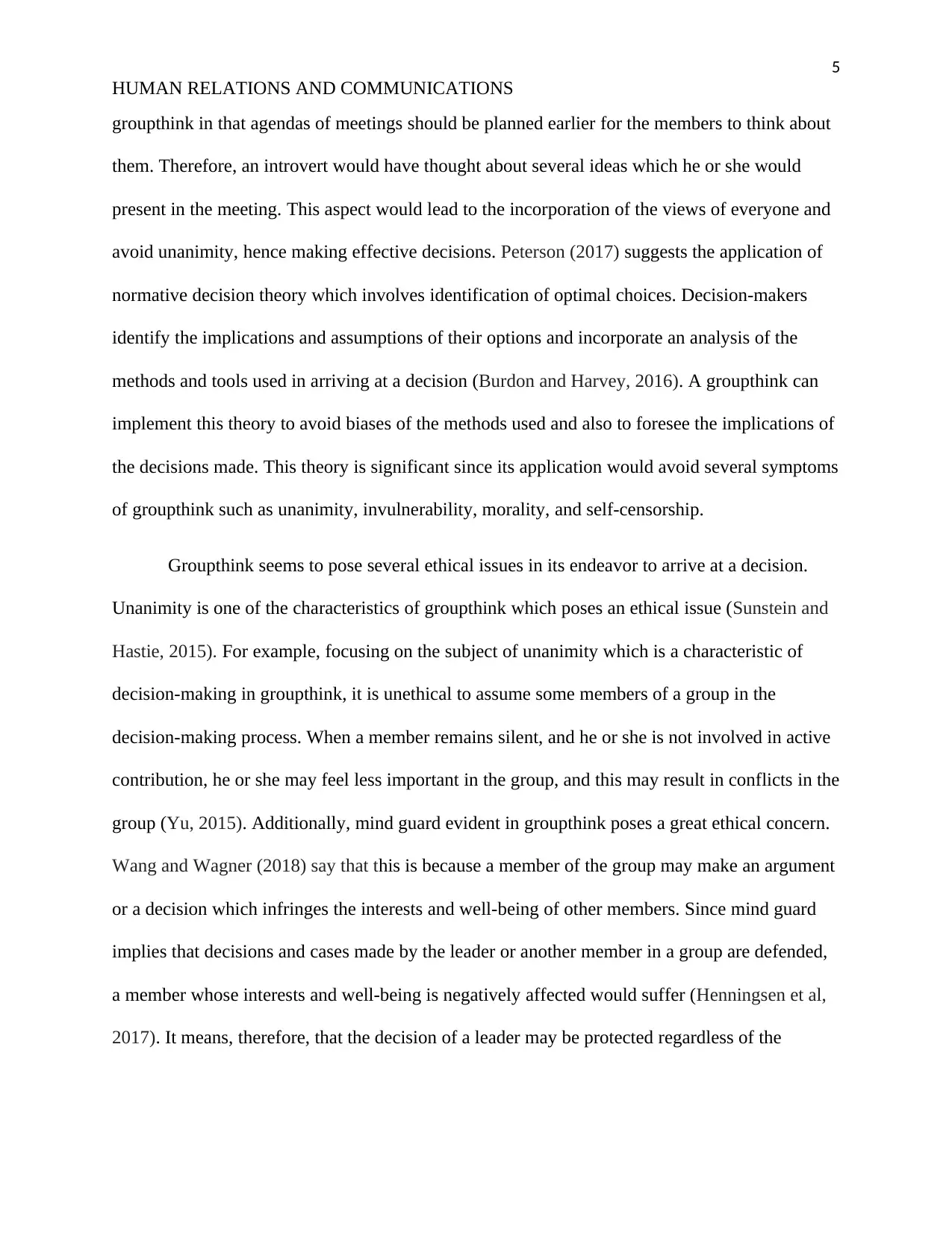
5
HUMAN RELATIONS AND COMMUNICATIONS
groupthink in that agendas of meetings should be planned earlier for the members to think about
them. Therefore, an introvert would have thought about several ideas which he or she would
present in the meeting. This aspect would lead to the incorporation of the views of everyone and
avoid unanimity, hence making effective decisions. Peterson (2017) suggests the application of
normative decision theory which involves identification of optimal choices. Decision-makers
identify the implications and assumptions of their options and incorporate an analysis of the
methods and tools used in arriving at a decision (Burdon and Harvey, 2016). A groupthink can
implement this theory to avoid biases of the methods used and also to foresee the implications of
the decisions made. This theory is significant since its application would avoid several symptoms
of groupthink such as unanimity, invulnerability, morality, and self-censorship.
Groupthink seems to pose several ethical issues in its endeavor to arrive at a decision.
Unanimity is one of the characteristics of groupthink which poses an ethical issue (Sunstein and
Hastie, 2015). For example, focusing on the subject of unanimity which is a characteristic of
decision-making in groupthink, it is unethical to assume some members of a group in the
decision-making process. When a member remains silent, and he or she is not involved in active
contribution, he or she may feel less important in the group, and this may result in conflicts in the
group (Yu, 2015). Additionally, mind guard evident in groupthink poses a great ethical concern.
Wang and Wagner (2018) say that this is because a member of the group may make an argument
or a decision which infringes the interests and well-being of other members. Since mind guard
implies that decisions and cases made by the leader or another member in a group are defended,
a member whose interests and well-being is negatively affected would suffer (Henningsen et al,
2017). It means, therefore, that the decision of a leader may be protected regardless of the
HUMAN RELATIONS AND COMMUNICATIONS
groupthink in that agendas of meetings should be planned earlier for the members to think about
them. Therefore, an introvert would have thought about several ideas which he or she would
present in the meeting. This aspect would lead to the incorporation of the views of everyone and
avoid unanimity, hence making effective decisions. Peterson (2017) suggests the application of
normative decision theory which involves identification of optimal choices. Decision-makers
identify the implications and assumptions of their options and incorporate an analysis of the
methods and tools used in arriving at a decision (Burdon and Harvey, 2016). A groupthink can
implement this theory to avoid biases of the methods used and also to foresee the implications of
the decisions made. This theory is significant since its application would avoid several symptoms
of groupthink such as unanimity, invulnerability, morality, and self-censorship.
Groupthink seems to pose several ethical issues in its endeavor to arrive at a decision.
Unanimity is one of the characteristics of groupthink which poses an ethical issue (Sunstein and
Hastie, 2015). For example, focusing on the subject of unanimity which is a characteristic of
decision-making in groupthink, it is unethical to assume some members of a group in the
decision-making process. When a member remains silent, and he or she is not involved in active
contribution, he or she may feel less important in the group, and this may result in conflicts in the
group (Yu, 2015). Additionally, mind guard evident in groupthink poses a great ethical concern.
Wang and Wagner (2018) say that this is because a member of the group may make an argument
or a decision which infringes the interests and well-being of other members. Since mind guard
implies that decisions and cases made by the leader or another member in a group are defended,
a member whose interests and well-being is negatively affected would suffer (Henningsen et al,
2017). It means, therefore, that the decision of a leader may be protected regardless of the
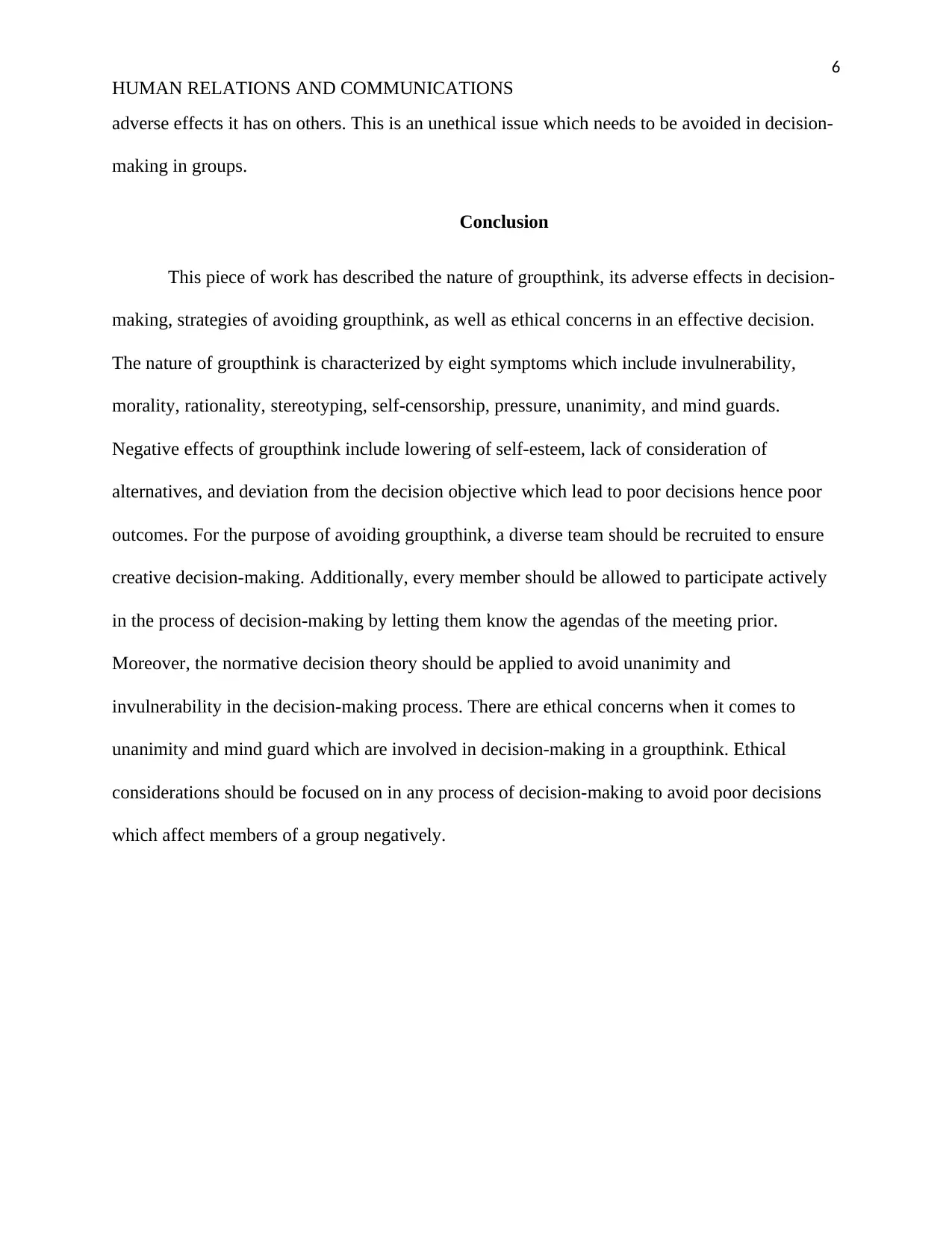
6
HUMAN RELATIONS AND COMMUNICATIONS
adverse effects it has on others. This is an unethical issue which needs to be avoided in decision-
making in groups.
Conclusion
This piece of work has described the nature of groupthink, its adverse effects in decision-
making, strategies of avoiding groupthink, as well as ethical concerns in an effective decision.
The nature of groupthink is characterized by eight symptoms which include invulnerability,
morality, rationality, stereotyping, self-censorship, pressure, unanimity, and mind guards.
Negative effects of groupthink include lowering of self-esteem, lack of consideration of
alternatives, and deviation from the decision objective which lead to poor decisions hence poor
outcomes. For the purpose of avoiding groupthink, a diverse team should be recruited to ensure
creative decision-making. Additionally, every member should be allowed to participate actively
in the process of decision-making by letting them know the agendas of the meeting prior.
Moreover, the normative decision theory should be applied to avoid unanimity and
invulnerability in the decision-making process. There are ethical concerns when it comes to
unanimity and mind guard which are involved in decision-making in a groupthink. Ethical
considerations should be focused on in any process of decision-making to avoid poor decisions
which affect members of a group negatively.
HUMAN RELATIONS AND COMMUNICATIONS
adverse effects it has on others. This is an unethical issue which needs to be avoided in decision-
making in groups.
Conclusion
This piece of work has described the nature of groupthink, its adverse effects in decision-
making, strategies of avoiding groupthink, as well as ethical concerns in an effective decision.
The nature of groupthink is characterized by eight symptoms which include invulnerability,
morality, rationality, stereotyping, self-censorship, pressure, unanimity, and mind guards.
Negative effects of groupthink include lowering of self-esteem, lack of consideration of
alternatives, and deviation from the decision objective which lead to poor decisions hence poor
outcomes. For the purpose of avoiding groupthink, a diverse team should be recruited to ensure
creative decision-making. Additionally, every member should be allowed to participate actively
in the process of decision-making by letting them know the agendas of the meeting prior.
Moreover, the normative decision theory should be applied to avoid unanimity and
invulnerability in the decision-making process. There are ethical concerns when it comes to
unanimity and mind guard which are involved in decision-making in a groupthink. Ethical
considerations should be focused on in any process of decision-making to avoid poor decisions
which affect members of a group negatively.
⊘ This is a preview!⊘
Do you want full access?
Subscribe today to unlock all pages.

Trusted by 1+ million students worldwide
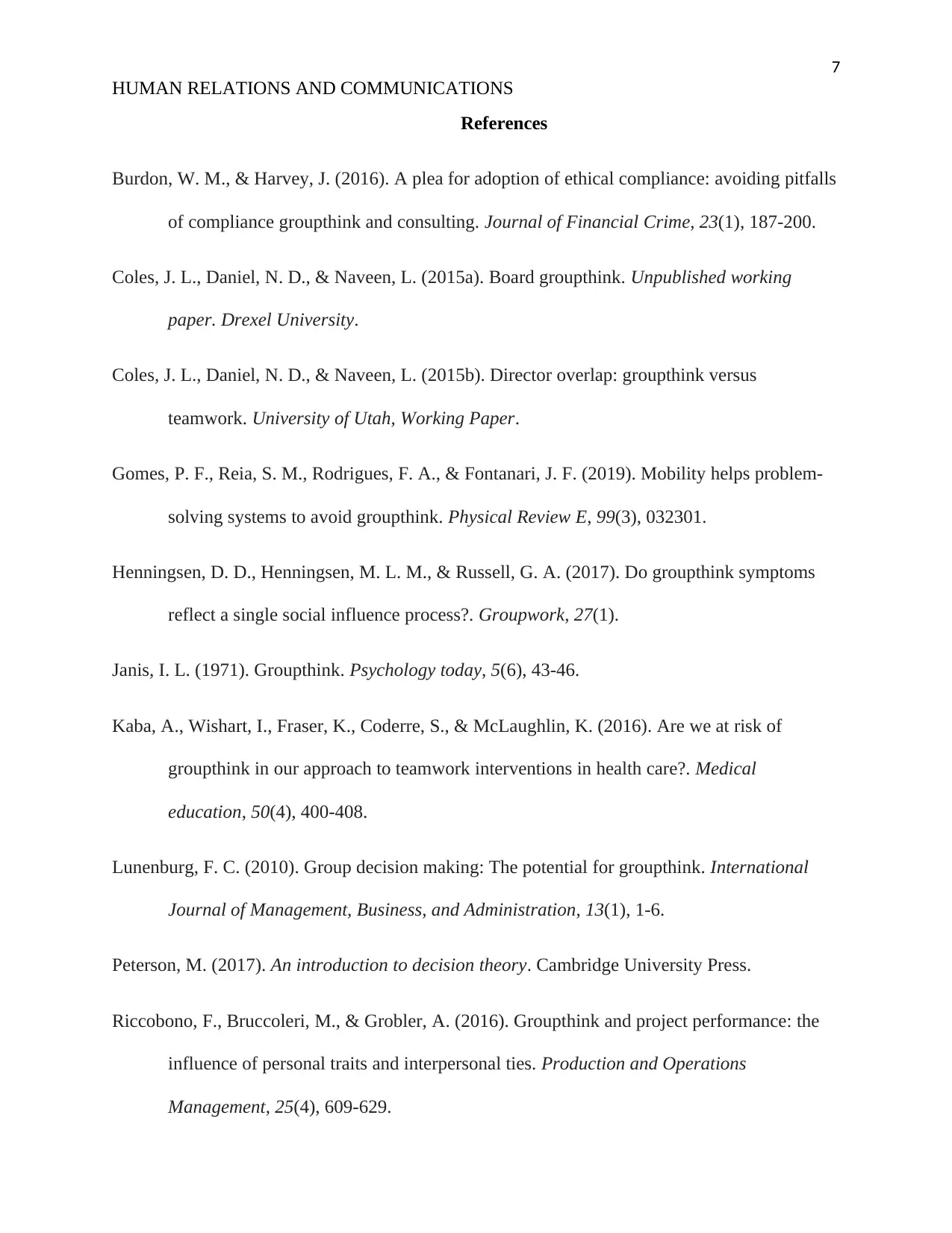
7
HUMAN RELATIONS AND COMMUNICATIONS
References
Burdon, W. M., & Harvey, J. (2016). A plea for adoption of ethical compliance: avoiding pitfalls
of compliance groupthink and consulting. Journal of Financial Crime, 23(1), 187-200.
Coles, J. L., Daniel, N. D., & Naveen, L. (2015a). Board groupthink. Unpublished working
paper. Drexel University.
Coles, J. L., Daniel, N. D., & Naveen, L. (2015b). Director overlap: groupthink versus
teamwork. University of Utah, Working Paper.
Gomes, P. F., Reia, S. M., Rodrigues, F. A., & Fontanari, J. F. (2019). Mobility helps problem-
solving systems to avoid groupthink. Physical Review E, 99(3), 032301.
Henningsen, D. D., Henningsen, M. L. M., & Russell, G. A. (2017). Do groupthink symptoms
reflect a single social influence process?. Groupwork, 27(1).
Janis, I. L. (1971). Groupthink. Psychology today, 5(6), 43-46.
Kaba, A., Wishart, I., Fraser, K., Coderre, S., & McLaughlin, K. (2016). Are we at risk of
groupthink in our approach to teamwork interventions in health care?. Medical
education, 50(4), 400-408.
Lunenburg, F. C. (2010). Group decision making: The potential for groupthink. International
Journal of Management, Business, and Administration, 13(1), 1-6.
Peterson, M. (2017). An introduction to decision theory. Cambridge University Press.
Riccobono, F., Bruccoleri, M., & Grobler, A. (2016). Groupthink and project performance: the
influence of personal traits and interpersonal ties. Production and Operations
Management, 25(4), 609-629.
HUMAN RELATIONS AND COMMUNICATIONS
References
Burdon, W. M., & Harvey, J. (2016). A plea for adoption of ethical compliance: avoiding pitfalls
of compliance groupthink and consulting. Journal of Financial Crime, 23(1), 187-200.
Coles, J. L., Daniel, N. D., & Naveen, L. (2015a). Board groupthink. Unpublished working
paper. Drexel University.
Coles, J. L., Daniel, N. D., & Naveen, L. (2015b). Director overlap: groupthink versus
teamwork. University of Utah, Working Paper.
Gomes, P. F., Reia, S. M., Rodrigues, F. A., & Fontanari, J. F. (2019). Mobility helps problem-
solving systems to avoid groupthink. Physical Review E, 99(3), 032301.
Henningsen, D. D., Henningsen, M. L. M., & Russell, G. A. (2017). Do groupthink symptoms
reflect a single social influence process?. Groupwork, 27(1).
Janis, I. L. (1971). Groupthink. Psychology today, 5(6), 43-46.
Kaba, A., Wishart, I., Fraser, K., Coderre, S., & McLaughlin, K. (2016). Are we at risk of
groupthink in our approach to teamwork interventions in health care?. Medical
education, 50(4), 400-408.
Lunenburg, F. C. (2010). Group decision making: The potential for groupthink. International
Journal of Management, Business, and Administration, 13(1), 1-6.
Peterson, M. (2017). An introduction to decision theory. Cambridge University Press.
Riccobono, F., Bruccoleri, M., & Grobler, A. (2016). Groupthink and project performance: the
influence of personal traits and interpersonal ties. Production and Operations
Management, 25(4), 609-629.
Paraphrase This Document
Need a fresh take? Get an instant paraphrase of this document with our AI Paraphraser
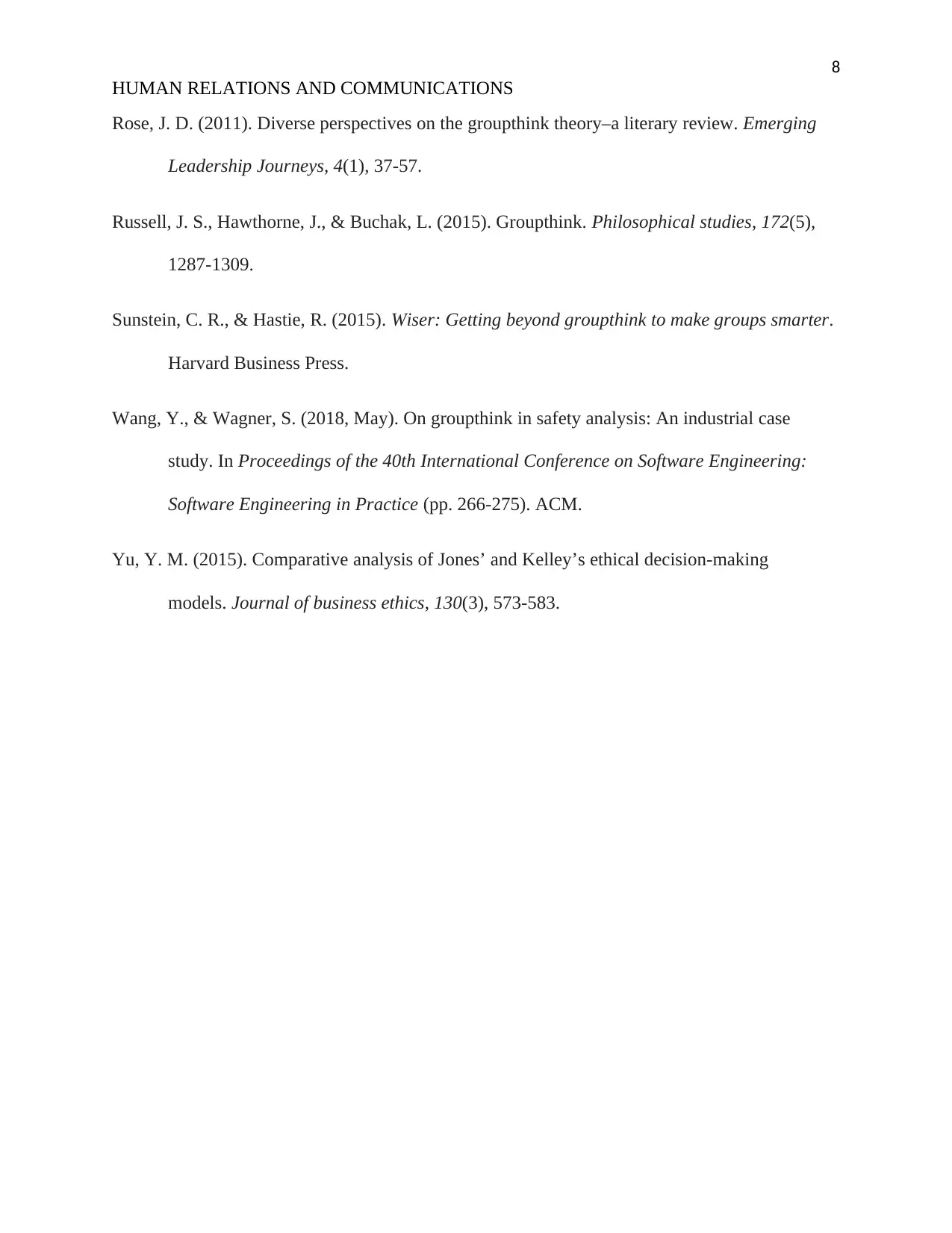
8
HUMAN RELATIONS AND COMMUNICATIONS
Rose, J. D. (2011). Diverse perspectives on the groupthink theory–a literary review. Emerging
Leadership Journeys, 4(1), 37-57.
Russell, J. S., Hawthorne, J., & Buchak, L. (2015). Groupthink. Philosophical studies, 172(5),
1287-1309.
Sunstein, C. R., & Hastie, R. (2015). Wiser: Getting beyond groupthink to make groups smarter.
Harvard Business Press.
Wang, Y., & Wagner, S. (2018, May). On groupthink in safety analysis: An industrial case
study. In Proceedings of the 40th International Conference on Software Engineering:
Software Engineering in Practice (pp. 266-275). ACM.
Yu, Y. M. (2015). Comparative analysis of Jones’ and Kelley’s ethical decision-making
models. Journal of business ethics, 130(3), 573-583.
HUMAN RELATIONS AND COMMUNICATIONS
Rose, J. D. (2011). Diverse perspectives on the groupthink theory–a literary review. Emerging
Leadership Journeys, 4(1), 37-57.
Russell, J. S., Hawthorne, J., & Buchak, L. (2015). Groupthink. Philosophical studies, 172(5),
1287-1309.
Sunstein, C. R., & Hastie, R. (2015). Wiser: Getting beyond groupthink to make groups smarter.
Harvard Business Press.
Wang, Y., & Wagner, S. (2018, May). On groupthink in safety analysis: An industrial case
study. In Proceedings of the 40th International Conference on Software Engineering:
Software Engineering in Practice (pp. 266-275). ACM.
Yu, Y. M. (2015). Comparative analysis of Jones’ and Kelley’s ethical decision-making
models. Journal of business ethics, 130(3), 573-583.
1 out of 8
Your All-in-One AI-Powered Toolkit for Academic Success.
+13062052269
info@desklib.com
Available 24*7 on WhatsApp / Email
![[object Object]](/_next/static/media/star-bottom.7253800d.svg)
Unlock your academic potential
Copyright © 2020–2025 A2Z Services. All Rights Reserved. Developed and managed by ZUCOL.

